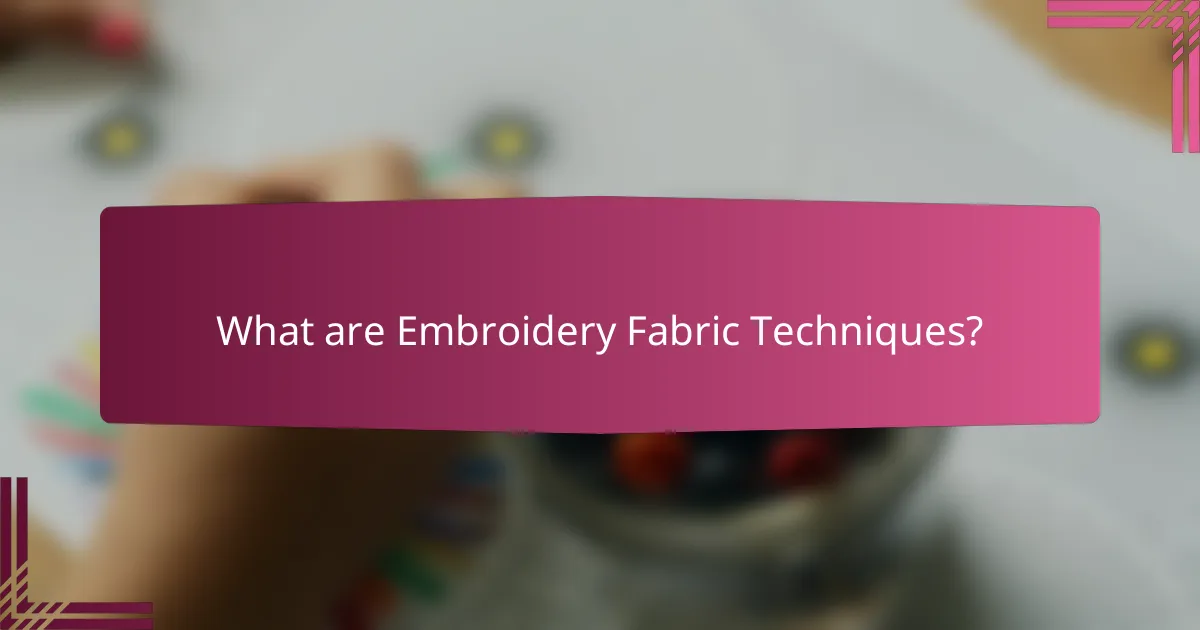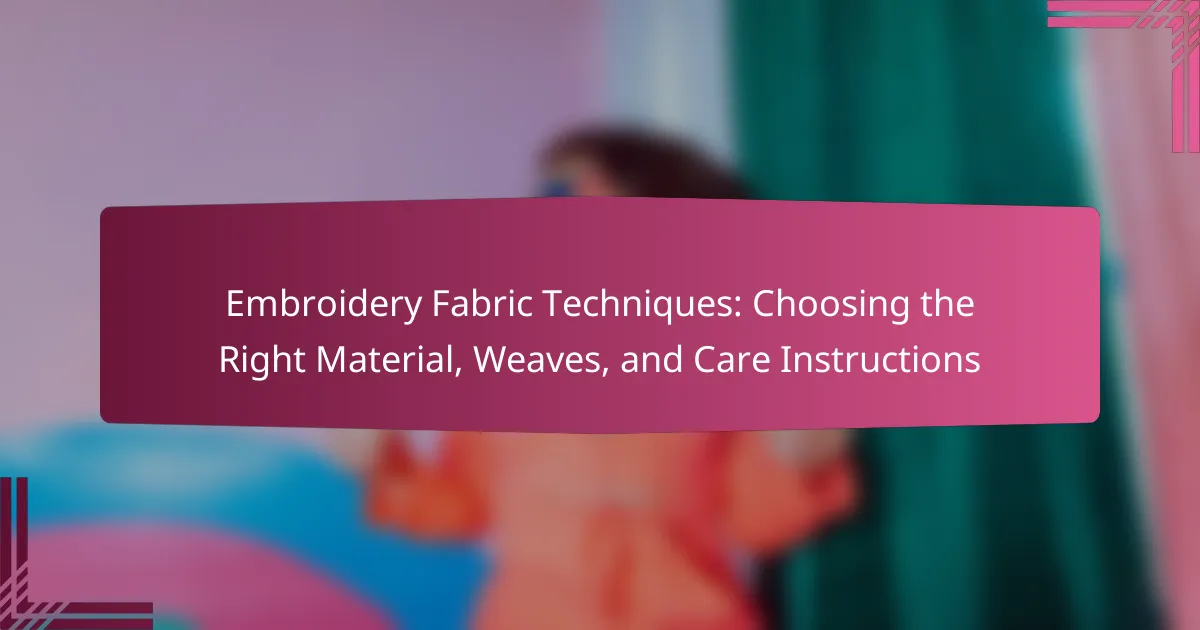
What are Embroidery Fabric Techniques?
Embroidery fabric techniques refer to the various methods used to apply decorative stitching on fabric. These techniques include hand embroidery, machine embroidery, and specialty techniques like appliqué and cross-stitch. Hand embroidery involves manually stitching designs onto fabric using needles and threads. Machine embroidery utilizes sewing machines to create intricate patterns quickly. Specialty techniques, such as appliqué, involve sewing a piece of fabric onto another to create designs. Each technique requires specific materials and tools tailored to the desired outcome. Understanding these techniques helps in selecting the right fabric and thread for successful embroidery projects.
How do different materials impact embroidery techniques?
Different materials significantly impact embroidery techniques. Fabrics like cotton, linen, and polyester each have unique properties affecting thread tension and stitch definition. Cotton is breathable and holds colors well, making it ideal for detailed designs. Linen has a textured surface that can enhance the visual appeal of embroidery but may require more care in handling. Polyester is durable and resistant to shrinking, which allows for consistent stitching over time.
The weight and weave of the fabric also influence the choice of embroidery techniques. Heavier fabrics may require stronger threads and different needle sizes. In contrast, lightweight materials can be more delicate and may need careful handling to avoid puckering.
Additionally, the finish of the fabric impacts how the embroidery appears. A smooth finish allows for clean, defined stitches, while a rough finish can create a more textured look. Understanding these material characteristics helps embroiderers select the right techniques for their projects.
What are the most common types of fabrics used in embroidery?
The most common types of fabrics used in embroidery are cotton, linen, polyester, and silk. Cotton is widely favored for its versatility and ease of use. Linen is known for its durability and natural texture. Polyester offers strength and resistance to wrinkles. Silk is prized for its luxurious feel and sheen. Each fabric type provides unique characteristics that enhance the embroidery process.
How does fabric weight affect the embroidery process?
Fabric weight significantly influences the embroidery process. Heavier fabrics tend to stabilize the embroidery, reducing the likelihood of distortion during stitching. This stability allows for cleaner, more precise designs. In contrast, lighter fabrics may shift or pucker, complicating the embroidery process. Additionally, the weight of the fabric can dictate the type of stabilizer needed. Heavier fabrics often require stronger stabilizers to support the design. The choice of thread also depends on fabric weight; thicker threads work better on heavier fabrics. Conversely, lighter fabrics benefit from finer threads to maintain a delicate appearance. Overall, understanding fabric weight is crucial for achieving high-quality embroidery results.
Why is the choice of weave important in embroidery?
The choice of weave is crucial in embroidery because it affects the fabric’s texture, durability, and how well it holds stitches. Different weaves create varying surfaces for embroidery. For instance, a tighter weave provides stability, preventing distortion of the design. Conversely, a looser weave may allow for more flexibility but can lead to uneven stitching. Additionally, the weave influences the fabric’s ability to absorb colors and maintain vibrancy. Fabrics like canvas or twill offer different results compared to satin or linen. Therefore, selecting the right weave ensures the final embroidery piece meets aesthetic and functional expectations.
What are the different types of weaves used in embroidery fabrics?
The different types of weaves used in embroidery fabrics include plain weave, twill weave, and satin weave. Plain weave is characterized by a simple over-and-under pattern, providing a sturdy and balanced fabric. Twill weave features a diagonal rib pattern, offering durability and a unique texture. Satin weave has a smooth surface with a high sheen, allowing for intricate embroidery designs. Each weave type impacts the fabric’s appearance and suitability for various embroidery techniques. For instance, satin weave is often preferred for detailed work due to its smooth finish.
How does the weave structure influence the final embroidery design?
The weave structure significantly influences the final embroidery design. Different weave types, such as plain, twill, or satin, affect the fabric’s texture and appearance. A plain weave provides a stable surface for embroidery, allowing for clear and defined stitches. Twill weaves create a diagonal pattern, adding depth and dimension to the design. Satin weaves offer a smooth, glossy finish that enhances the vibrancy of thread colors. The density of the weave also impacts how well the embroidery holds up over time. Tightly woven fabrics can support intricate designs without puckering. Conversely, loosely woven fabrics may result in uneven stitching and less durability. Ultimately, the choice of weave structure is crucial for achieving the desired aesthetic and functional qualities in embroidery.
What care instructions should be followed for embroidered fabrics?
Embroidered fabrics require specific care instructions to maintain their appearance and integrity. Hand washing is recommended to prevent damage to the embroidery. Use cold water and a mild detergent specifically designed for delicate fabrics. Avoid wringing or twisting the fabric, as this can distort the embroidery. Instead, gently press the fabric to remove excess water. Line drying or flat drying is preferred to avoid stretching. If ironing is necessary, use a low heat setting and place a cloth between the iron and the embroidery to protect it. Additionally, avoid bleach and harsh chemicals, as they can cause discoloration and damage. Following these care instructions helps preserve the quality of embroidered fabrics.
How should different types of embroidered fabrics be washed?
Different types of embroidered fabrics should be washed based on their specific care requirements. Cotton embroidered fabrics can usually be machine washed in cold water on a gentle cycle. Silk embroidered fabrics require hand washing in cold water with a mild detergent to prevent damage. Polyester embroidered fabrics can typically withstand machine washing in warm water, but should be dried on a low heat setting. For delicate or intricate embroidery, it’s advisable to place the fabric in a mesh laundry bag to protect it during washing. Always check the care label for specific instructions related to the fabric type. This ensures the longevity and appearance of the embroidered design.
What drying methods are safest for preserving embroidery?
The safest drying methods for preserving embroidery include air drying and flat drying. Air drying involves hanging the embroidered piece in a well-ventilated area away from direct sunlight. This method prevents fading and damage to the stitches. Flat drying requires placing the embroidery on a clean, dry surface, ensuring it retains its shape. Both methods minimize the risk of shrinkage and distortion. Using these techniques helps maintain the integrity of the threads and fabric.
How can you choose the right material for your embroidery project?
To choose the right material for your embroidery project, consider the fabric’s weight and texture. Lightweight fabrics like cotton are suitable for detailed designs. Heavier fabrics, such as canvas, work well for bold patterns. The fabric’s weave affects the embroidery’s appearance. A tighter weave provides better support for intricate stitches. Test the fabric with a sample stitch to gauge compatibility. Additionally, consider the fabric’s care instructions for long-term maintenance. Selecting the right thread type is also essential for achieving the desired finish.
What factors should you consider when selecting a weave for embroidery?
When selecting a weave for embroidery, consider the fabric’s texture, weight, and thread count. The texture influences how the embroidery design appears on the fabric. A smoother weave allows for more intricate designs, while a textured weave can add dimension. Weight affects the stability of the fabric during stitching. Heavier fabrics support more elaborate designs, whereas lighter fabrics may require stabilizers. Thread count indicates the density of the weave. A higher thread count typically provides a finer surface for detailed embroidery. Additionally, consider the fabric’s fiber content, as natural fibers like cotton and linen absorb dye differently than synthetic fibers. This affects the final appearance of the embroidery.
How do different weaves complement various embroidery techniques?
Different weaves enhance various embroidery techniques by providing unique textures and support. For instance, a plain weave offers a smooth surface ideal for detailed stitching. This allows intricate designs to stand out clearly. In contrast, a twill weave adds depth and dimension, making it suitable for raised embroidery styles. The diagonal pattern of twill helps in creating a more tactile finish. Additionally, specialty weaves like herringbone can offer unique visual effects that complement specific embroidery styles. These variations in weave structure influence how threads lay and interact with the fabric. Ultimately, the choice of weave directly affects the overall aesthetic and durability of the embroidered piece.
What are the best practices for caring for embroidered fabrics?
The best practices for caring for embroidered fabrics include gentle washing, air drying, and proper storage. Hand wash embroidered items in cold water with mild detergent. Avoid harsh chemicals that can damage the embroidery. If machine washing is necessary, use a delicate cycle and a mesh laundry bag. Air drying is preferred to prevent shrinkage and damage. Lay the fabric flat or hang it to dry away from direct sunlight. Store embroidered fabrics in a cool, dry place. Use acid-free tissue paper to prevent creasing and protect the embroidery. Regularly check for any signs of wear or damage to maintain the fabric’s quality.
How can you prevent damage to your embroidery during cleaning?
To prevent damage to your embroidery during cleaning, always hand wash it in cold water. Use a mild detergent specifically designed for delicate fabrics. Avoid wringing or twisting the embroidery, as this can distort the stitches. Instead, gently press the fabric between two clean towels to remove excess water. Lay the embroidery flat to dry, avoiding direct sunlight to prevent fading. If necessary, iron the embroidery on the reverse side using a low heat setting. These methods help maintain the integrity of the stitches and colors, ensuring your embroidery remains in pristine condition.
What storage tips help maintain the quality of embroidered fabrics?
Store embroidered fabrics flat to prevent creasing and distortion. Use acid-free tissue paper between layers to protect the embroidery. Avoid hanging embroidered items, as this can stretch the fabric. Keep them in a cool, dry place to prevent moisture damage. Use breathable storage bags to allow air circulation. Avoid plastic containers that can trap humidity. Regularly check stored fabrics for signs of pests or mold. These practices help preserve the quality and appearance of embroidered fabrics over time.
What common mistakes should be avoided when selecting embroidery materials?
Common mistakes to avoid when selecting embroidery materials include choosing the wrong fabric type. Different fabrics have varying thread counts and textures, impacting the final design. Not considering the weight of the fabric can lead to puckering or distortion in the embroidery. Additionally, neglecting to match the thread type with the fabric can result in poor adhesion or color mismatch. Failing to pre-wash fabrics may cause shrinkage after the embroidery is completed. Overlooking the importance of stabilizers can affect the embroidery’s durability and appearance. Lastly, ignoring the needle size can lead to thread breakage or fabric damage. These factors are crucial for achieving high-quality embroidery results.
Embroidery Fabric Techniques encompass various methods for applying decorative stitching on fabric, including hand and machine embroidery, as well as specialty techniques like appliqué and cross-stitch. The article explores how different materials, such as cotton, linen, polyester, and silk, impact embroidery techniques, emphasizing the importance of fabric weight and weave structure on the final design. Additionally, it provides essential care instructions for maintaining embroidered fabrics and highlights common mistakes to avoid when selecting materials, ensuring high-quality results in embroidery projects.
